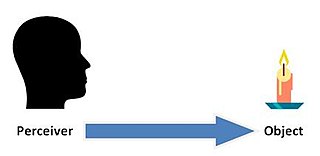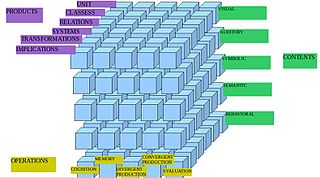
Consciousness, at its simplest, is awareness of internal and external existence. However, its nature has led to millennia of analyses, explanations and debates by philosophers, theologians, linguists, and scientists. Opinions differ about what exactly needs to be studied or even considered consciousness. In some explanations, it is synonymous with the mind, and at other times, an aspect of mind. In the past, it was one's "inner life", the world of introspection, of private thought, imagination and volition. Today, it often includes any kind of cognition, experience, feeling or perception. It may be awareness, awareness of awareness, or self-awareness either continuously changing or not. The disparate range of research, notions and speculations raises a curiosity about whether the right questions are being asked.
Epiphenomenalism is a position on the mind–body problem which holds that physical and biochemical events within the human body are the sole cause of mental events. According to this view, subjective mental events are completely dependent for their existence on corresponding physical and biochemical events within the human body, yet themselves have no influence over physical events. The appearance that subjective mental states influence physical events is merely an illusion. For instance, fear seems to make the heart beat faster, but according to epiphenomenalism the biochemical secretions of the brain and nervous system —not the experience of fear—is what raises the heartbeat. Because mental events are a kind of overflow that cannot cause anything physical, yet have non-physical properties, epiphenomenalism is viewed as a form of property dualism.
Internalism and externalism are two opposite ways of integration of explaining various subjects in several areas of philosophy. These include human motivation, knowledge, justification, meaning, and truth. The distinction arises in many areas of debate with similar but distinct meanings. Internal–external distinction is a distinction used in philosophy to divide an ontology into two parts: an internal part concerning observation related to philosophy, and an external part concerning question related to philosophy.
Phenomenology is the philosophical study of objectivity – and reality more generally – as subjectively lived and experienced.
Artificial consciousness (AC), also known as machine consciousness (MC), synthetic consciousness or digital consciousness, is the consciousness hypothesized to be possible in artificial intelligence. It is also the corresponding field of study, which draws insights from philosophy of mind, philosophy of artificial intelligence, cognitive science and neuroscience. The same terminology can be used with the term "sentience" instead of "consciousness" when specifically designating phenomenal consciousness.
The Eight Consciousnesses is a classification developed in the tradition of the Yogācāra school of Mahayana Buddhism. They enumerate the five sense consciousnesses, supplemented by the mental consciousness (manovijñāna), the defiled mental consciousness (kliṣṭamanovijñāna), and finally the fundamental store-house consciousness (ālāyavijñāna), which is the basis of the other seven. This eighth consciousness is said to store the impressions (vāsanāḥ) of previous experiences, which form the seeds (bīja) of future karma in this life and in the next after rebirth.
Experience refers to conscious events in general, more specifically to perceptions, or to the practical knowledge and familiarity that is produced by these processes. Understood as a conscious event in the widest sense, experience involves a subject to which various items are presented. In this sense, seeing a yellow bird on a branch presents the subject with the objects "bird" and "branch", the relation between them and the property "yellow". Unreal items may be included as well, which happens when experiencing hallucinations or dreams. When understood in a more restricted sense, only sensory consciousness counts as experience. In this sense, experience is usually identified with perception and contrasted with other types of conscious events, like thinking or imagining. In a slightly different sense, experience refers not to the conscious events themselves but to the practical knowledge and familiarity they produce. In this sense, it is important that direct perceptual contact with the external world is the source of knowledge. So an experienced hiker is someone who actually lived through many hikes, not someone who merely read many books about hiking. This is associated both with recurrent past acquaintance and the abilities learned through them.

The Critique of Pure Reason is a book by the German philosopher Immanuel Kant, in which the author seeks to determine the limits and scope of metaphysics. Also referred to as Kant's "First Critique", it was followed by his Critique of Practical Reason (1788) and Critique of Judgment (1790). In the preface to the first edition, Kant explains that by a "critique of pure reason" he means a critique "of the faculty of reason in general, in respect of all knowledge after which it may strive independently of all experience" and that he aims to reach a decision about "the possibility or impossibility of metaphysics". The term "critique" is understood to mean a systematic analysis in this context, rather than the colloquial sense of the term.

In the philosophy of perception and philosophy of mind, direct or naïve realism, as opposed to indirect or representational realism, are differing models that describe the nature of conscious experiences; out of the metaphysical question of whether the world we see around us is the real world itself or merely an internal perceptual copy of that world generated by our conscious experience.

Tsongkhapa was an influential Tibetan Buddhist monk, philosopher and tantric yogi, whose activities led to the formation of the Gelug school of Tibetan Buddhism. He is also known by his ordained name Losang Drakpa or simply as "Je Rinpoche". He is also known by Chinese as Zongkapa Lobsang Zhaba or just Zōngkābā (宗喀巴).
A mental state, or a mental property, is a state of mind of a person. Mental states comprise a diverse class, including perception, pain/pleasure experience, belief, desire, intention, emotion, and memory. There is controversy concerning the exact definition of the term. According to epistemic approaches, the essential mark of mental states is that their subject has privileged epistemic access while others can only infer their existence from outward signs. Consciousness-based approaches hold that all mental states are either conscious themselves or stand in the right relation to conscious states. Intentionality-based approaches, on the other hand, see the power of minds to refer to objects and represent the world as the mark of the mental. According to functionalist approaches, mental states are defined in terms of their role in the causal network independent of their intrinsic properties. Some philosophers deny all the aforementioned approaches by holding that the term "mental" refers to a cluster of loosely related ideas without an underlying unifying feature shared by all. Various overlapping classifications of mental states have been proposed. Important distinctions group mental phenomena together according to whether they are sensory, propositional, intentional, conscious or occurrent. Sensory states involve sense impressions like visual perceptions or bodily pains. Propositional attitudes, like beliefs and desires, are relations a subject has to a proposition. The characteristic of intentional states is that they refer to or are about objects or states of affairs. Conscious states are part of the phenomenal experience while occurrent states are causally efficacious within the owner's mind, with or without consciousness. An influential classification of mental states is due to Franz Brentano, who argues that there are only three basic kinds: presentations, judgments, and phenomena of love and hate.
Association of ideas, or mental association, is a process by which representations arise in consciousness, and also for a principle put forward by an important historical school of thinkers to account generally for the succession of mental phenomena. The term is now used mostly in the history of philosophy and of psychology. One idea was thought to follow another in consciousness if it were associated by some principle. The three commonly asserted principles of association were similarity, contiguity, and contrast, numerous others had been added by the nineteenth century. By the end of the nineteenth century physiological psychology was so altering the approach to this subject that much of the older associationist theory was rejected.
The Grammar of Science is a book by Karl Pearson first published in hardback in 1892. In 1900, the second edition, published by Adam & Charles Black, appeared. The third, revised, edition was also published by Adam & Charles Black in 1911. It was recommended by Einstein to his friends of the Olympia Academy. Several themes were covered in this book that later became part of the theories of Einstein and other scientists, such as:
Apperception is any of several aspects of perception and consciousness in such fields as psychology, philosophy and epistemology.
Indefinite monism is a philosophical conception of reality that asserts that only awareness is real and that the wholeness of reality can be conceptually thought of in terms of immanent and transcendent aspects. The immanent aspect is denominated simply as awareness, while the transcendent aspect is referred to as omnific awareness.
The theory of sense data is a view in the philosophy of perception, popularly held in the early 20th century by philosophers such as Bertrand Russell, C. D. Broad, H. H. Price, A. J. Ayer, and G. E. Moore. Sense data are taken to be mind-dependent objects whose existence and properties are known directly to us in perception. These objects are unanalyzed experiences inside the mind, which appear to subsequent more advanced mental operations exactly as they are.

Mental operations are operations that affect mental contents. Initially, operations of reasoning have been the object of logic alone. Pierre Janet was one of the first to use the concept in psychology. Mental operations have been investigated at a developmental level by Jean Piaget, and from a psychometric perspective by J. P. Guilford. There is also a cognitive approach to the subject, as well as a systems view of it.
Mental factors, in Buddhism, are identified within the teachings of the Abhidhamma. They are defined as aspects of the mind that apprehend the quality of an object, and that have the ability to color the mind. Within the Abhidhamma, the mental factors are categorized as formations concurrent with mind. Alternate translations for mental factors include "mental states", "mental events", and "concomitants of consciousness".
Ratnakīrti was an Indian Buddhist philosopher of the Yogācāra and epistemological (pramāṇavāda) schools who wrote on logic, philosophy of mind and epistemology. Ratnakīrti studied at the Vikramaśīla monastery in modern-day Bihar. He was a pupil of Jñānaśrīmitra, and Ratnakīrti refers to Jñānaśrīmitra in his work as his guru with phrases such as yad āhur guravaḥ.
The Svatantrika-Prasaṅgika distinction is a set of arguments about two different positions of emptiness philosophy which are debated within the Mahayana school of Buddhism. It is most prominently discussed in Tibetan Buddhism where Prāsaṅgika and Svātantrika, are viewed to be different forms of Madhyamaka philosophy.




